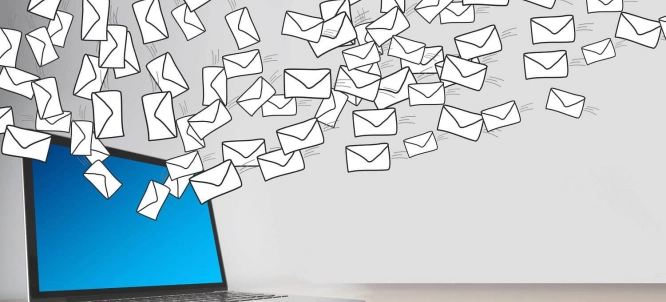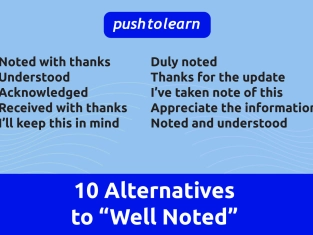by PushtoLearn
Email thread vs Email trail
Table of Contents
Email thread vs Email trail - Exercise and Quiz
What Do They Mean?
Both "email thread" and "email trail" relate to a series of emails exchanged on a particular topic, but they highlight different aspects of that exchange.
⭐ Email Thread: An email thread refers to the entire sequence of emails, including all replies, forwards, and responses, that are connected by a single subject line or topic. This term emphasizes the conversation aspect, where each email is a part of the ongoing discussion.
⭐ Email Trail: An email trail focuses more on the chronological list or "trail" of all the previous emails in the conversation. It often refers to the full history of emails in a conversation, usually seen when the entire string of messages is forwarded or referenced. The term "trail" is often used when you want to review the sequence of events or interactions.
Which One Is Correct?
Email Thread: Use this when referring to the back-and-forth conversation or exchange of emails. For example, "Please check the email thread for the details."
Email Trail: Use this when referring to the entire history or log of messages, especially when you need to review or share the complete series of emails. For example, "I forwarded the email trail to our manager."

Common Errors
A common mistake is using "email trail" when you actually mean "email thread," and vice versa. Remember:
⭐ "Email thread" = ongoing conversation.
⭐ "Email trail" = full history or sequence of messages.
Everyday Use
In everyday communication, you might use these terms like this:
Email Thread:
"Let's keep all updates in the same email thread to avoid confusion." (This means you want everyone to reply to the same email chain, maintaining the conversation in one place.)
Email Trail:
"Can you review the email trail before our meeting? It includes all the important discussions." (This means you should look at the entire history of emails to understand the context.)
Examples Using "Email Thread"
➡️ Work Collaboration: "Please respond to the original email thread so we can keep all project updates in one place." (Here, "email thread" refers to keeping the conversation about the project within the same email chain.)
➡️ Customer Support: "Our support team is following up on the email thread you started last week about your order." (This means the support team is continuing the conversation that began in a previous email.)
➡️ Team Communication: "Can we move this discussion to a separate email thread? The current one is getting too long and off-topic." (This suggests starting a new conversation in a different email chain to keep things organized.)
➡️ Formal Request: "I’ve included John in the email thread so he’s aware of our discussion." (This means John is now part of the ongoing conversation by being added to the existing email chain.)
➡️ Meeting Coordination: "Let’s stick to one email thread to finalize the meeting agenda." (This emphasizes the importance of keeping all related emails in one conversation.)
More examples for "Email Thread"
-
"I’ll forward you the email thread so you can catch up."
-
"Please read the entire email thread before the meeting."
-
"The issue was already discussed in the email thread from last week."
-
"Our teacher shared the project instructions in the email thread."
-
"Can you find the Zoom link in the old email thread?"
-
"I replied to the email thread with my homework file."
-
"Let’s keep all updates in the same email thread."
-
"He accidentally started a new email instead of replying to the thread."
-
"This email thread is getting too long—maybe we should schedule a call."
Examples Using "Email Trail"
➡️ Legal Context: "Please review the email trail for all communication regarding the contract." (Here, "email trail" refers to the complete history of emails exchanged about the contract, which might be important for legal reasons.)
➡️ Project Handoff: "I forwarded the entire email trail to the new project manager so she’s up to date on all decisions." (This means the new manager has received the full history of emails related to the project.)
➡️ Clarifying Information: "You can find all the details in the email trail that started last month." (This suggests checking the full sequence of emails to find the needed information.)
➡️ Escalating an Issue: "I’m sending the email trail to our supervisor to get their input on the issue." (This means forwarding the complete history of emails so the supervisor can understand the entire situation.)
➡️ Final Review: "Before we proceed, let’s go through the email trail to ensure we haven’t missed any critical points."
(This suggests reviewing the entire sequence of emails to confirm all important details have been addressed.)
More examples for "Email Trail"
-
"Please check the email trail for all the client’s requests."
-
"We have a full email trail showing the delivery dates."
-
"I attached the email trail to support our claim."
-
"The email trail shows when the assignment was submitted."
-
"Let’s include the professor’s reply in the email trail."
-
"The email trail confirms that the project topic was approved."
-
"There’s a clear email trail proving we followed the instructions."
-
"She reviewed the email trail before responding to the complaint."
-
"He deleted part of the email trail before forwarding it."
Writing emails takes time. You need to know some basic rules and cliches to write faster. There are few ways as to how to respond to I miss you emails. Try remembering the difference between Thank you everyone vs Thank you all and Incoming and Upcoming for clarity and better writing.
FAQ
Can I use "email trail" and "email thread" interchangeably?
Not exactly. While they are related, "email thread" is better for discussing ongoing conversations, and "email trail" is better for referring to the entire history of emails.
What’s the best way to keep an email thread organized?
Always reply to the original email and avoid changing the subject line unless necessary. This keeps the thread intact.
How do I find an old email in a thread?
Scroll through the email thread or search for specific keywords in your email client.
Is "email trail" commonly used in professional settings?
Yes, "email trail" is often used when sharing the full sequence of messages with someone, especially in formal or legal contexts.
How can I avoid a confusing email thread?
Keep your replies focused on the main topic and avoid discussing multiple subjects in one email thread.
Podcast Transcript
[0:00]
Host 1: Today, we’re diving into the difference between email threads and email trails. Ever found yourself tangled up in a long email chain, or wondered how to pass on a project’s communication history? Well, get ready. By the time we’re done, you’ll be email ninjas!
Host 2: Oh yeah! And let’s face it, it’s about more than just sounding impressive in your next meeting. Understanding these terms can make your communication clearer—something essential in fast-paced work environments.
[0:26]
Host 1: Exactly. So, let’s break it down. What is an email thread?
Host 2: Think of it like a written conversation. It’s the back and forth of replies and forwards under a single subject line.
Host 1: Right. So, as long as everything stays under that subject, it’s part of the same thread.
Host 2: Exactly, which is why nailing the subject line is crucial. It’s like giving the conversation a title.
[0:45]
Host 1: Makes sense. Especially in fast-paced environments, a clear subject line is like organizing your inbox—a lifesaver!
Host 2: Definitely. It’s like “measure twice, cut once,” but for email.
[0:56]
Host 1: Now, where does an email trail come into this?
Host 2: Good question. A trail is more of a chronological record of an entire conversation. Think of it as a digital paper trail.
Host 1: Oh, so like when you hand off a project, you’d share the trail to show all the decisions and discussions up to that point?
Host 2: Exactly! Or imagine a legal situation—that trail shows exactly who said what and when.
[1:20]
Host 1: So, it’s not just about sounding smart. It’s about choosing the right tool for the job—thread versus trail.
Host 2: Yep! Especially with complex projects, knowing the difference between sharing a thread or a trail can be crucial.
[1:30]
Host 1: Totally. And in today’s world, so much of our communication is digital. Getting it right matters.
Host 2: Absolutely. Even with instant messaging and project management tools, when something needs to be official, we still turn to email.
Host 1: It’s the record keeper of the business world!
[1:45]
Host 2: For sure. And using the right terms shows you’re on top of your game.
Host 1: Okay, so what are some common mistakes people make with these terms?
[1:52]
Host 2: The biggest one? Using "email trail" when they really mean "thread." Remember: a thread is the conversation, the back and forth. A trail is the full historical record.
Host 1: Got it. That’s super helpful!
[2:03]
Host 1: But what about those threads that just get ridiculously long? Any tips for managing them?
Host 2: Clear subject lines are key. Make sure everyone’s sticking to the same thread with relevant subjects. It makes searching through long conversations so much easier.
Host 1: Ah yes, the inbox-as-a-filing-cabinet approach versus total chaos!
[2:20]
Host 2: Exactly. And don’t forget about email search functions and filters—they’re like personal assistants for your inbox.
[2:30]
Host 1: Speaking of the future, will email always look like this? Threads and trails?
Host 2: That’s a great question. With tech evolving, like instant messaging and video calls, email will probably adapt too.
Host 1: True. Will we even need terms like thread and trail in the future?
[2:50]
Host 2: Maybe not! Imagine a system that pulls all relevant info on a topic automatically—no more sifting through long chains!
Host 1: That sounds amazing—and a bit sci-fi. But it feels like we’re heading that way with project management tools already organizing communication in one place.
Host 2: Totally. Imagine if your inbox gave you intelligent summaries of key info instead of long chains.
Host 1: My productivity just shot up 100% thinking about that!
[3:20]
Host 2: And that’s just email. Think about how all our communication—messaging, calls—could be seamlessly integrated.
Host 1: Mind blown. But even if we get super-powered inboxes, understanding threads and trails still matters today.
Host 2: Absolutely. Knowing those basics will help us make better decisions about the future of communication.
Host 1: Totally. Who knows, we might be reminiscing about the “good old days” of reply-all emails!
[3:45]
Host 2: True! But for today, what’s the key takeaway for our listeners?
Host 1: I’d say, choose your words carefully. Understanding the difference between thread and trail shows you know the nuances of digital communication.
Host 2: It might seem small, but in a fast-paced environment, it makes a difference.
Host 1: Exactly. So, next time you hit reply all, think like an email ninja and craft that perfect response. Is it a thread or a trail?
[Closing Scene]
Host 2: And maybe, just maybe, you’ll spark a conversation about the future of email while you’re at it!
Host 1: Thanks for joining us on this journey to email enlightenment. Until next time, may your inboxes be organized and your communication crystal clear!

